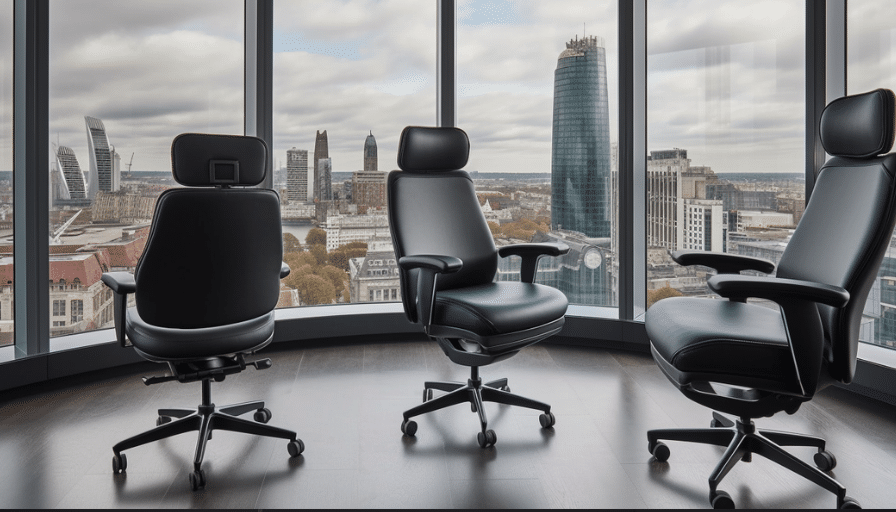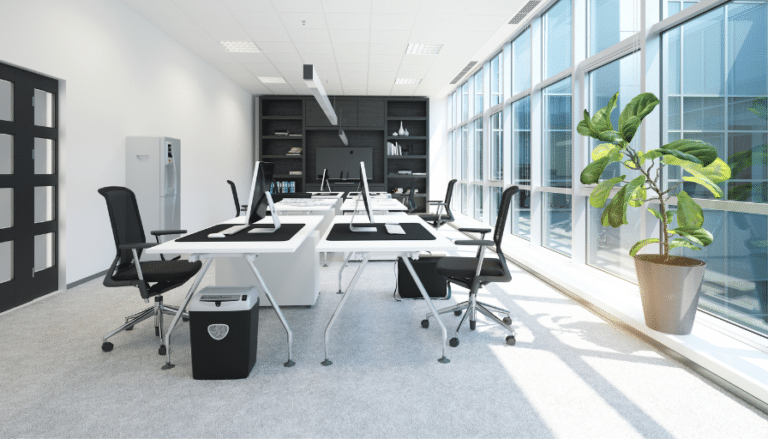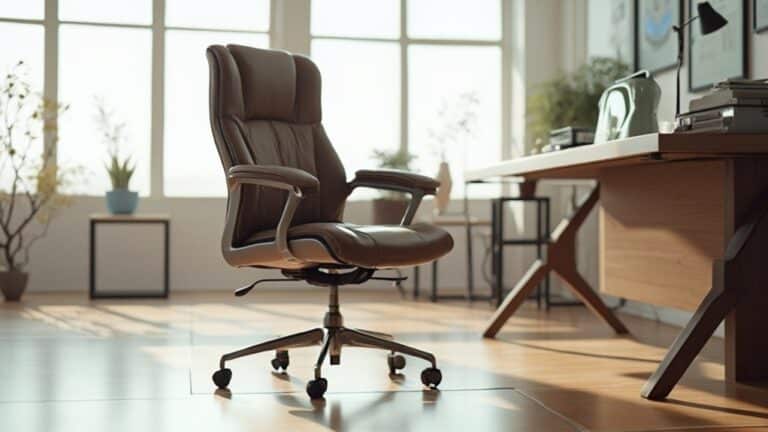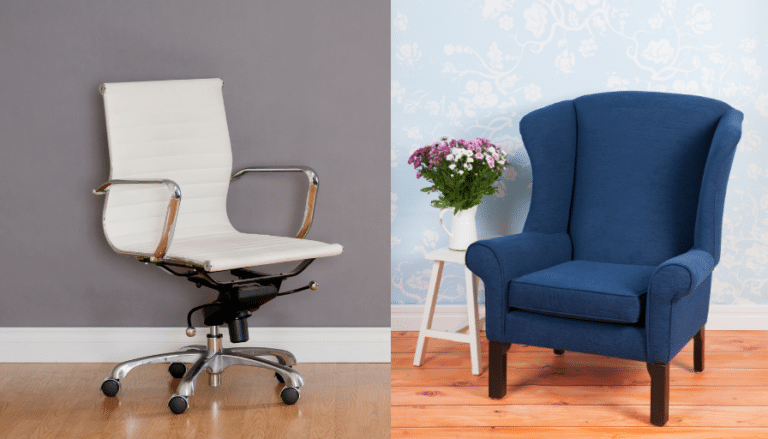How Often Should Office Chairs Be Replaced
When it comes to office chairs, knowing when to replace them can be vital for your comfort and productivity. Most chairs have a lifespan of 5 to 10 years, but it really depends on their quality and how often you use them. Are you noticing signs of wear and tear? Understanding these indicators can help you make informed decisions about your seating arrangements. Let’s explore what to look for next.
Average Lifespan of Office Chairs
When it comes to office chairs, you can generally expect them to last between 5 to 10 years, depending on their quality and how often you use them. High-quality chairs can stretch that lifespan to around 15 years with proper maintenance. The materials also play a significant role; fabric chairs typically last about eight years, while leather chairs can endure for a decade. Frequent and intensive use, like rocking back and forth or sharing the chair among multiple users, will wear it out faster.
Environmental factors, such as extreme temperatures or humidity, can also impact longevity. Regular cleaning and maintenance, including lubricating moving parts, are essential in extending your chair’s lifespan, as proper care and maintenance can significantly enhance durability.
Additionally, high-quality materials and craftsmanship are crucial for prolonging the lifespan of your office chair. It’s important to note that the average lifespan of office chairs is around seven years, which emphasizes the need for timely replacements. Moreover, usage frequency and intensity affect wear on chair components, highlighting the importance of mindful usage.
Identifying Signs of Wear and Tear
When you’re sitting in your office chair, pay attention to any visible damage like frayed fabric or cracks in the frame. If you’re starting to feel discomfort or notice your chair isn’t supporting you as it used to, that’s another clear sign. Also, keep an ear out for any squeaks or wobbles, as these mechanical issues can indicate it’s time for a replacement.
Regular inspections for visible signs of wear and tear can help you catch these issues before they escalate. Additionally, if you experience compromised support during prolonged sitting, it may be a signal that your chair needs replacing. Remember that heavy daily use may necessitate replacing your chair every 5 to 7 years, so consider its usage frequency as well. It’s also important to note that compressed foam in seat cushions can significantly reduce support over time, leading to increased discomfort.
Visible Damage Indicators
Visible damage indicators on your office chair can reveal a lot about its condition and whether it’s time for a replacement. Look closely for frayed or torn fabric, which not only affects aesthetics but also comfort. Cracked leather and fading colors signal deterioration, while persistent stains can weaken fabric quality.
Check for mechanical issues, too; loose screws and broken components indicate serious problems. If your chair squeaks or has stuck wheels, it’s time to reassess. Structural integrity matters as well—visible cracks in the frame or a wobbly base compromise safety.
Finally, if the seat sags or the backrest misaligns, you might be better off investing in a new chair for your workspace. Regular maintenance can significantly extend lifespan, helping to delay the need for replacement. Additionally, high-quality materials can ensure that your chair withstands daily wear and tear, reducing the frequency of replacements.
Comfort Level Decline
Your office chair’s visible damage isn’t the only sign that it might be time for a change; comfort level decline plays a significant role in determining its usability.
If you find yourself experiencing discomfort after sitting for long hours, it’s a clear indicator that your chair isn’t providing the support you need. Additionally, the quality of materials used in your chair can significantly affect its longevity and comfort. Persistent back and neck pain can signal inadequate ergonomic features, while fatigue and distraction often stem from lack of comfort. Additionally, notice if you feel tingling or numbness in your hands, as this could point to poor support.
If the padding feels less resilient or temperature regulation isn’t working, it may be time to contemplate a replacement to maintain your health and productivity. Ignoring these symptoms can lead to chronic health issues, making timely replacement crucial for your well-being.
Component Functionality Issues
Although a comfortable office chair is essential for productivity, component functionality issues can signal it’s time for a replacement.
Look for signs of wear and tear, such as loose screws or misaligned legs, which can create instability. If your wheels or casters are damaged or stuck, they hinder smooth movement, making your workspace less efficient.
Broken wheels or casters can also lead to mobility issues that may affect your productivity. Regular maintenance can help identify common problems before they require a full replacement. Additionally, excessive weight can accelerate the sinking issue, so be mindful of the chair’s weight capacity.
Pay attention to the gas lift; if your chair sinks unexpectedly, it may indicate a failing pneumatic cylinder. Additionally, examine armrests for cracks or looseness, as these can lead to discomfort.
Finally, inspect upholstery for tears or stains—damaged fabric not only looks unappealing but can also affect your comfort. If you notice these issues, consider replacing your chair for ideal functionality.
Importance of Ergonomic Considerations
When you prioritize ergonomic considerations in your office chair selection, you’re investing in your long-term health and productivity. Ergonomic chairs offer adjustable seat heights and armrests, ensuring you maintain proper posture and reduce strain on your back and shoulders. This prevents discomfort and enhances focus, making you more efficient at work.
Features like lumbar support and backrest adjustments support your spine’s natural curve, while the swivel function allows easy movement without straining. By promoting pelvic alignment and reducing health risks, these chairs help you avoid chronic pain.
Ultimately, choosing an ergonomic chair leads to a more comfortable work experience, boosting your job satisfaction and supporting your overall well-being. Additionally, the inclusion of adjustable features in ergonomic chairs can be tailored to individual user preferences, enhancing overall comfort and usability. Regular chair replacements are essential for maintaining optimal long-term comfort.
Budgeting and Replacement Planning
When it comes to budgeting for office chair replacements, you’ll want to take into account effective replacement cycle strategies that fit your financial situation. Investing in high-quality chairs might seem costly upfront, but it can save you money by reducing frequent replacements. Ergonomic advancements in office chair technology can also enhance user experience and productivity, making it a wise long-term investment.
Additionally, recognizing that the average lifespan of an office chair is 7 to 10 years can help you plan your replacement schedule more effectively. Planning for these expenses not only guarantees a comfortable workspace but also supports employee productivity in the long run.
Replacement Cycle Strategies
To maintain a productive work environment, it’s essential to develop effective replacement cycle strategies for office chairs.
Start by evaluating usage; if chairs face heavy use, plan for replacements every 5 to 7 years. Keep in mind the warranty periods—chairs with 5-year warranties may last longer, while those with 10 years can serve up to 15 years with proper care.
Regular maintenance helps extend chair longevity, so perform inspections and fix issues early. Additionally, stay aware of changing ergonomic standards; chairs that no longer support proper posture should be replaced. Proper wheels reduce the risk of injuries related to chair movement, making it crucial to consider their condition during replacements.
Finally, integrate replacement strategies into your budget, considering options like replacing 20% of chairs annually or cycling all chairs every 5 years.
Cost-Effectiveness Considerations
Developing effective replacement cycle strategies helps lay the groundwork for understanding cost-effectiveness in office chair management.
When planning your budget, consider the following factors:
- Initial Costs: Invest in high-quality chairs to reduce frequent replacements.
- Refurbishment Costs: Weigh the cost of refurbishing versus buying new; it can be more economical.
- Maintenance Costs: Regular upkeep can prolong chair life and minimize expenses.
- Cost Per Use: Calculate how much each chair costs over its lifespan to find the best value.
Additionally, proper support for the back is essential for maintaining comfort and productivity, which can further influence overall cost-effectiveness. Investing in ergonomic office chairs not only enhances comfort but also promotes long-term employee well-being.
Furthermore, implementing circular economy principles can help optimize chair usage and reduce waste, ultimately leading to more sustainable office management. Moreover, choosing chairs with enhanced durability ensures they withstand prolonged use, significantly contributing to cost-effectiveness over time.
Maintenance Strategies for Longevity
Maintaining your office chair is essential for ensuring its longevity and maximizing comfort. Regularly clean your chair to prevent dirt buildup, which can wear down the materials.
Lubricate moving parts like caster wheels with silicone-based products to reduce friction and squeaking.
Frequently check and tighten loose screws or bolts to keep the chair structurally sound. Remember to care for specific materials—leather, mesh, and fabric all need tailored cleaning methods.
Inspect for signs of wear and tear, and replace any broken components promptly. Cheap office chairs often have lower-quality materials, so it’s crucial to monitor their condition closely. Regular inspections can help identify potential issues before they become significant problems, ensuring comfort and functionality for daily use.
Use chairs within their weight capacity and adjust settings to maintain ergonomic support.
By implementing these maintenance strategies, you’ll extend your chair’s lifespan and enhance your overall office experience.
Organizational Benefits of Quality Chairs
While many may overlook the importance of quality office chairs, investing in them can greatly enhance an organization’s overall efficiency and employee satisfaction.
Here are some key organizational benefits you can expect:
- Ergonomic Support: Quality chairs promote natural posture, reducing the risk of chronic pain.
- Increased Productivity: Comfortable seating enhances focus, leading to higher output.
- Employee Retention: Happy employees are likely to stay longer, improving job satisfaction.
- Professional Image: Well-designed chairs reflect your commitment to employee well-being and create a positive impression on clients.
Frequently Asked Questions
What Types of Office Chairs Last the Longest?
When considering office chairs, look for leather or 3D knit options; they typically last 8-10 years. High-quality brands like Herman Miller also guarantee durability, so investing in a good chair pays off long-term.
Can I Repair My Office Chair Instead of Replacing It?
Yes, you can repair your office chair instead of replacing it. Minor issues like squeaky wheels or loose screws often fix easily. Regular maintenance also helps prolong its life, saving you money and reducing waste.
How Do I Choose the Right Chair for My Size?
To choose the right chair for your size, measure your seat height, depth, and width, ensuring it accommodates your body type. Look for adjustable features to customize support and maximize comfort during use.
Are There Eco-Friendly Options for Office Chairs?
Yes, there are eco-friendly options for office chairs. Look for chairs made with recycled materials, bamboo frames, and sustainable manufacturing processes. These choices minimize environmental impact while providing comfort and durability for your workspace.
How Can I Dispose of Old Office Chairs Responsibly?
To dispose of old office chairs responsibly, consider local recycling centers, donation options, or junk removal services. Disassembling parts can also help recycle components, minimizing waste and supporting eco-friendly practices in your community.
Conclusion
To sum up, replacing your office chair every 5 to 10 years is key to maintaining comfort and productivity. Keep an eye out for signs of wear and prioritize ergonomic designs to support your well-being. Budgeting for replacements and implementing maintenance strategies will extend your chair’s lifespan, ensuring you get the most out of your investment. Remember, quality chairs not only enhance your workspace but also contribute to a healthier, more productive work environment.
References
- https://www.think-office-furniture.co.uk/how-often-should-you-replace-office-chairs/
- https://ehs.web.baylor.edu/sites/g/files/ecbvkj1581/files/2023-03/when_to_replace_an_office_chair.pdf
- https://sihoooffice.com/blogs/guide/how-often-should-you-replace-office-chairs-a-comprehensive-guide-to-workplace-ergonomics
- https://www.americandesignonline.com/office-furniture/when-is-it-time-to-replace-your-office-chair/
- https://de.sihoooffice.com/de/blogs/bloggen/the-ultimate-guide-to-when-and-why-you-should-replace-office-chairs
- https://offisavvy.com/how-long-do-office-chairs-last-and-when-to-replace-them/
- https://ergotune.com/blogs/articles/how-long-do-desk-chairs-last
- https://www.kieurope.com/about-us/blog/how-often-should-you-replace-office-chairs/
- https://vaseat.com/how-long-should-you-replace-office-chair/
- https://aceofficesystems.com/blogs/news/signs-its-time-to-replace-your-office-chair








